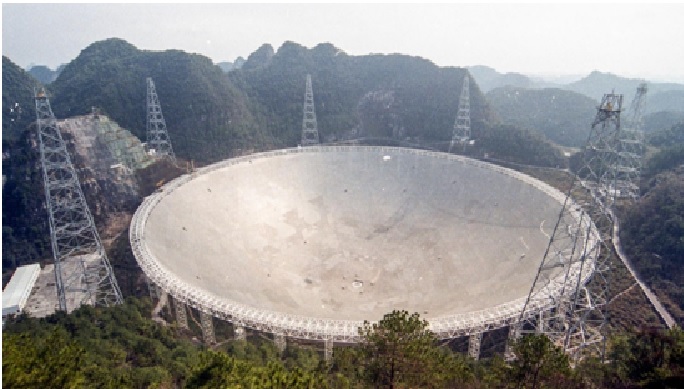China’s World’s Largest New Radio Telescope and Solar Eruptions
Construction of the world’s largest circular radio telescope array aimed at the sun – located in southwest China – is expected to be finished by the end of the year, according to the project’s supervisor.

Figure 1. China’s the world’s largest circular radio telescope array.
Figure 1 shows that the Daocheng Solar Radio Telescope (DSRT) is being built at a site high up on the Tibetan Plateau and will have 313 dishes, each of them 6 meters (19.7 feet) across.
It will be used to study dangerous solar eruptions known as coronal mass ejections – when magnetized plasma escapes from the sun’s upper atmosphere and propagates in the interplanetary space.
These eruptions are believed to have caused major geomagnetic storms on Earth, including the Carrington Event in 1859 during which telegraph stations all over Europe and North America failed. [1]
The DSRT will be used alongside the Mingantu interplanetary scintillation telescope – also solar and currently being assembled on the grasslands of Inner Mongolia to the north – and will put China at the forefront of space weather research.
The Mingantu telescope aims to monitor the sun in an indirect way, by detecting how radio signals from deep space are scattered by solar winds. But the DSRT will take direct images of the sun in radio waves with a frequency range between 150 and 450 megahertz.
Wu Junwei said, “the DSRT will be the world’s largest circular array for solar radio imaging, and enable more accurate observation of coronal mass ejections,” and good progress had been made on the building work and it should be completed by the end of 2022. [2]
The telescope’s hundreds of parabolic, or dish, antennas will be equally spaced around a 3.14km (1.95-mile) circle. A 100-metre tower stands in the center and will have a transmitter mounted on top to help with accurate calibration of the array.
An algorithm has been developed to optimize the array’s configuration which, when tested on 16 of the antennas, was found to work well. In addition to research, the observatory will also be open to the public and used for science outreach, Wu told China News Service.
It will be part of a planned 7-billion-yuan (US$1.04 billion) astronomy and archaeology park in Daocheng, a county in the west of Sichuan province. Announcing the project on Wednesday last week, Garze prefecture officials said they aimed to make it a world-class tourist destination. [3]
References:
- https://www.scmp.com/news/china/science/article/3184087/chinas-new-radio-telescope-will-have-dangerous-solar-eruptions
- https://sg.news.yahoo.com/china-radio-telescope-dangerous-solar-115509257.html
- https://www.msn.com/en-us/news/technology/china-s-new-radio-telescope-will-have-dangerous-solar-eruptions-in-its-gaze/ar-AAZbXol?ocid=wispr&li=BBnbfcL
Cite this article:
Sri Vasagi K (2022), China’s World’s Largest New Radio Telescope and Solar Eruptions, AnaTechMaz, pp.115















